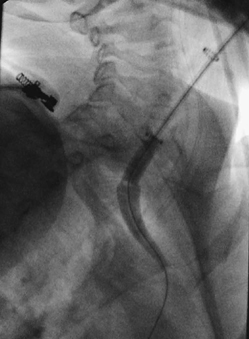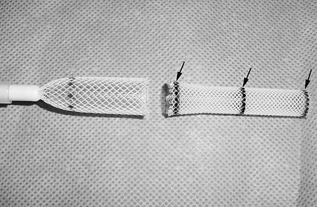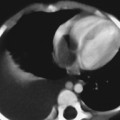CASE 104 A 5-year-old male presents with a history of tracheoesophageal fistula, having had several surgical attempts at repair, which were unsuccessful. The final surgery was a gastric pull-up that resulted in a stricture at the anastomosis. Endoscopic attempts at repairing or dilating the stricture were unsuccessful and resulted in a fistula to the skin surface. Image-guided dilatations were performed, with recurrence of the stricture soon after. A decision was made to place a stent. Figure 104A Contrast esophageal study demonstrates a complete stricture with a small sinus to outer skin in the area of the upper chest and shows the catheter and dilator with wire at the site of the stricture (Fig. 104A). Figure 104B Rusch polyflex silicone-coated stent. Recurrent stricture at the site of anastomosis Tracheoesophageal strictures in the pediatric population can occur through a variety of causes and may result in major airway collapse. Stents are used to establish and maintain luminal continuity and have become an extremely valuable technique in the management of these patients. A variety of stent designs are available for both the trachea and esophagus, each with distinct advantages and drawbacks. Generally, there are two subtypes of stent design: metallic and silicone (Fig. 104B). The arrows show radiopaque markers. In the pediatric population, metallic stents are used more often than silicone. Improvements in silicone stent technology including a decrease in wall thickness will likely increase their use in the pediatric population. A major advantage of silicone stents, as compared with metallic stents, is their ease of removal. Rare erosions, fistulizations, and even death during attempted removal have been reported with metallic stents. Most silicone stents are designed as a solid cylinder, as opposed to the perforated or honeycombed design of the metallic stents. Metallic stents are more appropriate for placement over airway branch orifices that would otherwise be blocked by the solid silicone stent. As stent technology continues to improve, it will likely become the primary treatment option for many pediatric conditions that affect the lumen of the tracheobronchial tree and esophagus. Several conditions may result in a decrease in tracheal or esophageal luminal area. In such patients, stenting may be required to maintain patency.
Clinical Presentation

Radiologic Findings

Diagnosis
Discussion
Background
Etiology
Stay updated, free articles. Join our Telegram channel

Full access? Get Clinical Tree








